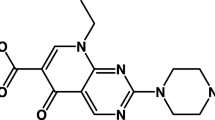Summary
The antibacterial activity of hexamine and two of its organic acid salts was compared by continuous turbidimetric monitoring of static cultures exposed to the drugs and in anin vitro model of the treatment of bacterial cystitis. At pH 5.5, concentrations of 32 to 125 mg hexamine per 1 caused some inhibition of bacterial growth, but 250 to 500 mg/l were needed to suppress growth overnight. Hexamine hippurate was found to be less active than hexamine itself, whereas hexamine mandelate was as active as the parent compound. The antibacterial effect was not inoculum dependent over the range 106 to 108 bacteria per ml, but the activity observed in pooled urine was rather less than that found in broth at the same pH. When a dense bacterial culture was exposed to changing concentrations of hexamine compounds in the bladder model, a 1 g dose infused over a 12-hour period suppressed bacterial growth for 16 to 20 hours. No systematic difference was found in the activity of the three hexamine compounds, but a similar effect was achieved by a very much lower concentration of ampicillin.
Zusammenfassung
Die antibakterielle Aktivität von Hexamin und zwei seiner Salze organischer Säuren wurden durch kontinuierliche turbidimetrische Kontrolle stehender Kulturen unter Einwirkung der Substanzen und in einemin vitro Modell zur Behandlung der bakteriellen Zystitis überprüft. Bei pH 5,5 war das Bakterienwachstum mit Hexamin in Konzentrationen von 32 bis 125 mg/l bis zu einem gewissen Grad zu hemmen, jedoch wurden Konzentrationen von 250 bis 500 mg/l benötigt, um das Wachstum über Nacht zu unterdrükken. Die Aktivität von Hexaminhippurat war geringer als die von Hexamin selbst; hingegen war Hexaminmandelat ebenso aktiv wie die Muttersubstanz. In einem Bereich von 106 bis 108 Bakterien pro ml war der antibakterielle Effekt nicht inokulumabhängig; die in gepooltem Urin beobachtete Aktivität war eher geringer als die bei identischem pH in Bouillon festgestellte Wirksamkeit. Bei Expositionsversuchen von dichten Bakterienkulturen gegenüber wechselnden Konzentrationen von Hexaminverbindungen im Blasenmodell zeigte sich, daß eine über 12 Stunden infundierte Dosis von 1 g das Bakterienwachstum für 16 bis 20 Stunden unterdrückte. Grundsätzliche Unterschiede zwischen den drei Hexaminverbindungen fanden sich dabei nicht. Es ist allerdings festzustellen, daß mit Ampicillin in sehr viel geringeren Konzentrationen ein ähnlicher Effekt zu erzielen war.
Similar content being viewed by others
Literature
Greenwood, D., O'Grady, F. Comparison of the responses ofEscherichia coli andProteus mirabilis to seven β-lactam antibiotics. J. Infect. Dis. 128 (1973) 211–222.
Mackintosh, I. P., O'Grady, F., Greenwood, D., Watson, B. W., Crichton, T. C., Piper, R., Ferrer, A. A twelve channel bacterial growth monitoring system. Biomed. Eng. 8 (1973) 514–515, 526.
Greenwood, D., O'Grady, F. Anin vitro model of the urinary bladder. J. Antimicrob. Chemother. 4 (1978) 113–120.
Seneca, H., Peer, P. Clinical pharmacology and antibacterial action of methenamine and its salts. Med. Times (N. Y.) 97 (1969) 243–251.
Miller, H., Phillips, E. Antibacterial correlates of urine drug levels of hexamethylenetetramine and formaldehyde. Invest. Urol. 8 (1970) 21–33.
Brumfitt, W., Hamilton-Miller, J. M. T. Sulphonamides, trimethoprim-sulphamethoxazole, nalidixic acid, oxolinic acid, methenamine, and nitrofurans. In:Kagan, B. M. (ed.): Antimicrobial Therapy. W. B. Saunders Company, Philadelphia 1980, pp. 137–152.
Bodel, P. T., Cotran, R., Kass, E. H. Cranberry juice and the antibacterial action of hippuric acid. J. Lab. Clin. Med. 54 (1959) 881–888.
Musher, D. M., Griffith, D. P. Generation of formaldehyde from methenamine: effect of pH and concentration, and antibacterial effect. Antimicrob. Agents Chemother. 6 (1974) 708–711.
Freeman, R. B., Bromer, L., Brancato, F., Cohen, S. I., Garfield, C. F., Griep, R. J., Hinman, E. J., Richardson, J. A., Thurm, R. H., Urner, C., Smith, W. M. Prevention of recurrent bacteriuria with continuous chemotherapy. Ann. Intern. Med. 69 (1968) 655–672.
Gow, J. G. A comparative trial of hexamine hippurate and hexamine mandelate in prevention of recurrent infection of the urinary tract. Practitioner 213 (1974) 97–101.
Author information
Authors and Affiliations
Rights and permissions
About this article
Cite this article
Greenwood, D., Slack, R.C.B. The antibacterial activity of hexamine (methenamine), hexamine hippurate and hexamine mandelate. Infection 9, 223–227 (1981). https://doi.org/10.1007/BF01640720
Received:
Published:
Issue Date:
DOI: https://doi.org/10.1007/BF01640720




